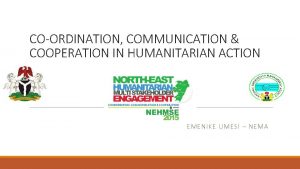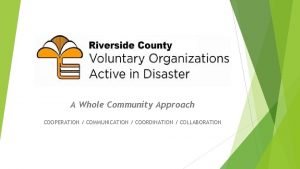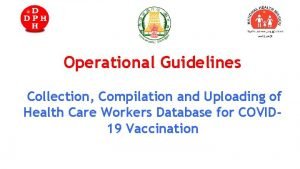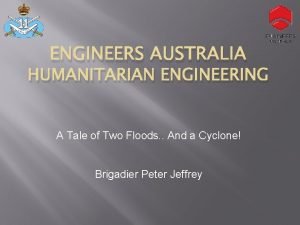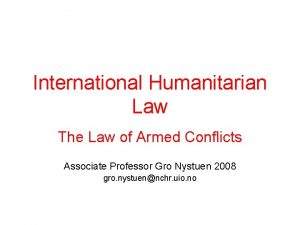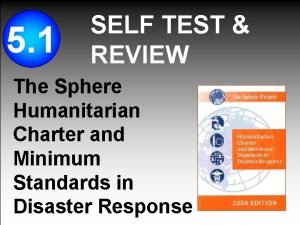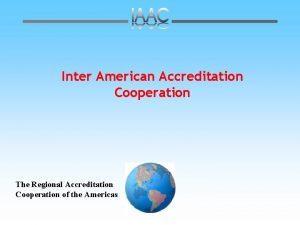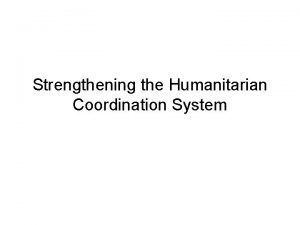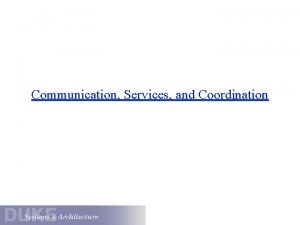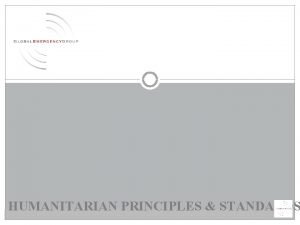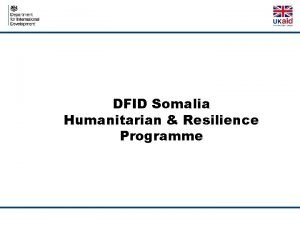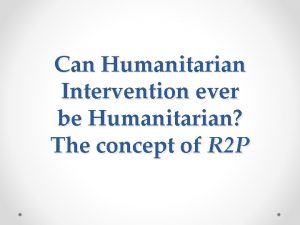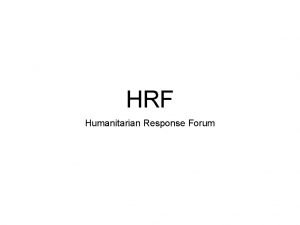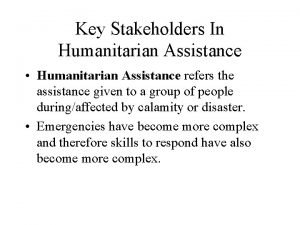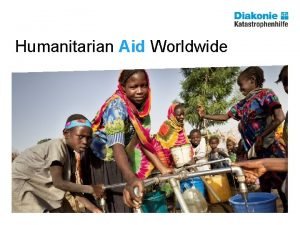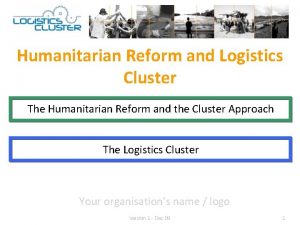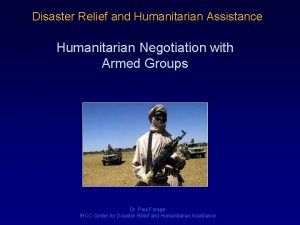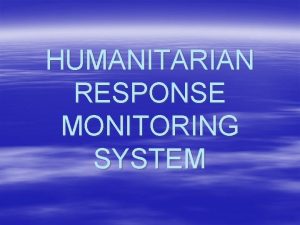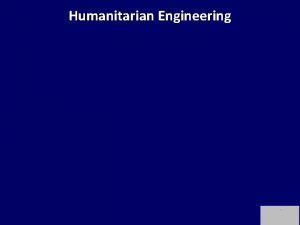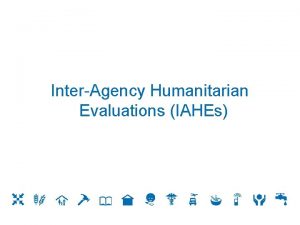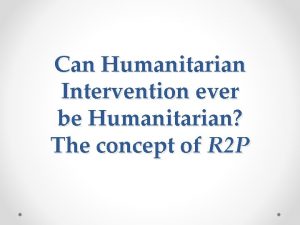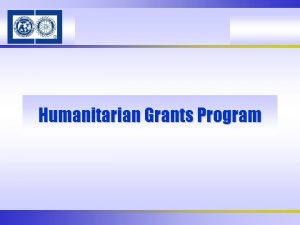COORDINATION COMMUNICATION COOPERATION IN HUMANITARIAN ACTION EMENIKE UMESI




























- Slides: 28

CO-ORDINATION, COMMUNICATION & COOPERATION IN HUMANITARIAN ACTION EMENIKE UMESI – NEMA

CONTENT 1. DISASTER MANAGEMENT IN NIGERIA 2. NATIONAL COORDINATION MECHANISM 3. SECTOR DYNAMICS IN HUMANITARIAN ACTION IN NIGERIA 4. THREE Cs OF HUMANITARIAN ACTION 5. BENEFITS OF THE THREE Cs 6. SETTING THE TONE FOR THIS ENGAGEMENT 7. CONCLUSION

Objective of the Presentation This presentation has the objective of 1. Tracing the history of disaster management in Nigeria. 2. Discussing the 3 Cs in relation to humanitarian activities in Nigeria 3. Setting the basis for deliberation in this multi stakeholder engagement

Evolution of Disaster Management in Nigeria 1999 1906 • Fire Brigade 1976 Decree 48 • National Emergency Relief Agency (NERA) Act 12 as amended by act 50 • National Emergency Management Agency (NEMA)

STRUCTURE OF DISASTER MANAGEMENT IN NIGERIA It is run on the four levels of governance ◦ Federal ◦ State ◦ Local government ◦ Community It also involves the Non Governmental Organizations, CBOs, FBOs, INGOs, United Nations system, International development partners and donors. NEMA is the national focal organization for emergency management in Nigeria.

LEGAL & INSTITUTIONAL FRAMEWORK The National Emergency Management Agency was established by Act 12 as amended by Act 50 of 1999. This establishes the structure and relationships of governmental and non governmental organizations including ministries, departments, individuals and the private sector in the emergency management sector. It dictates the institutional arrangement for disaster mitigation and management which includes the establishment of single entity at each level of government such as National Emergency Management Agency (NEMA) responsible for coordination of such activities and maintaining communication and coordination. SEMA at State and LEMC at Local Level and Community based management structures

GA 46/182: Lead Role of Government in Humanitarian Response ‘Each State has the responsibility first and foremost to take care of victims of natural disasters and other emergencies occurring on its territory. Hence, the affected State has the primary role in the initiation, organization, coordination, and implementation of humanitarian assistance within its territory. ’ ‘States whose populations are in need of humanitarian assistance are called upon to facilitate the work of these organizations in implementing humanitarian assistance, in particular the supply of food, medicines, shelter and health care, for which access to victims is essential’

Responsibilities of the government Provide leadership to the response Ensure mechanisms for coordination with humanitarian partners Facilitate easy entry and exit of non-residential humanitarian partners, personnel, goods and equipment Facilitate legal status of operations of non-residential humanitarian partners Provide “Humanitarian space”: Ability of humanitarian actors to work independently and impartially in pursuit of humanitarian imperative

Supporting role of humanitarian partners No organisation has a comprehensive mandate or the capacity to assist and protect a large number of vulnerable populations alone.

Responsibilities of humanitarian partners Needs and beneficiary based assistance: Aid that seeks to save lives and alleviate suffering, including support to existing services (such as food, water, health, shelter, education, etc) Protection: All activities aimed at ensuring respect for the rights of the individual in accordance with the letter and the spirit of relevant bodies of law, including international human rights, humanitarian, and refugee law Protection should always be integrated into humanitarian assistance

NATIONAL DISASTER MANAGEMENT SYSTEM This show the horizontal and vertical relationship/structure of disaster management in Nigeria.

DISASTER MANAGEMENT SYSTEM IN NIGERIA

TOOLS FOR DISASTER MANAGEMENT The Agency as part of her responsibility as the national focal organisation in collaboration with stakeholders have developed the following plans amongst others to enhance disaster management in Nigeria: National Disaster Response Plan National Disaster Management Framework National Contingency Plan National Influenza Pandemic Preparedness & Response Plan (NIPPRP) National Nuclear & Radiological Emergency Plan Search And Rescue & Epidemic Evacuation Plan National Contingency Plan on Infrastructural Resuscitation Joint Humanitarian Action Plan etc.

ESTABLISHMENT OF SECTORS AND INTER SECTOR WORKING GROUPS The development of the National Contingency Plan in 2010 ushered in the sector based humanitarian response system in Nigeria. It is subdivided into : A) 1. National organisations under the leadership of the DG NEMA coordinated by NEMA 2. UN and INGOs under the leadership of HCT coordinated by the UNOCHA B) Nine (9) and later, twelve (12) humanitarian sectors are created with national organisations as lead and international organisations as co-lead.

NATIONAL SECTOR LEADS Sector/Cluster 1. Food Security Designated Lead MINISTRY OF AGRIC 2. Camp Coordination & Camp Mgmt NEMA/SEMA 3. Early Recovery 4. Education NEMA MINISTRY OF EDUCATION 5. Emergency Shelter 6. Emergency Telecommunications NEMA/ NRC MOComm. Tech 7. Health MINISTRY OF HEALTH 8. Logistics NEMA 9. Nutrition 10. Protection 11. Water, Sanitation & Hygiene 12. Information MOH NHRC MINISTRY OF WATER RESOURCES Min of Info

GLOBAL SECTOR LEADS Sector/Cluster 1. Food Security Designated Co-Lead FAO 2. Camp Coordination & Camp Mgmt UNHCR & IOM 3. Early Recovery UNDP 4. Education 5. Emergency Shelter 6. Emergency Telecommunications UNICEF & Save the Children UNHCR & IFRC OCHA, UNICEF & WFP 7. Health WHO 8. Logistics WFP 9. Nutrition UNICEF 10. Protection UNHCR 11. Water, Sanitation & Hygiene UNICEF

MDAs with sectoral roles in the management of Disasters Sectors Camp coordination & Camp management Lead / Co-Lead Organization NEMA/ SEMA/IOM Water, sanitation & Hygiene MOWR/UNICEF Education Health Early recovery Security Protection Food security Emergency shelter/ NFI Nutrition Information/Communication Ministry of Education/UNICEF Min. Of Health/ WHO NEMA/UNDP Police/NSCDC Human Rights commission/UNHCR Min. Of Agric. /FAO NEMA/SEMA/IOM MOH/UNICEF

THE THREE Cs OF EMERGENCY MANAGEMENT The three c model in emergency management is for 1. Co-ordination 2. Cooperation 3. and Communication.

Three Cs 1. Coordination allows all personnel and agencies to effectively work together even though each entity may have a different way of conducting operations. Collaboration allows all agencies work together for the same objectives - in emergency management, these objectives often follow a three phased goal of saving lives, scene stabilization being second and property protection being third. 3. Cooperation is simply an act and entities cooperating with one and other while working towards that common objective. Finally communication. . . 4. Communication is often seen as a cornerstone of emergency management - entities must be able to properly communicate with one and other and in an effective and critical manner otherwise an emergency can lead to a disaster in the end

BARRIERS TO COORDINATION /COOPERATION/COMMUNICATION Organisational Pride/ego/personality Conflicting mandate/goals/agenda and priorities Hidden agenda Mistrust or lack of confidence in coordinators Considered waste of time/time consuming Probable loss of power/autonomy/identity Differing focus/mandates/methodologies Inadequate top-level (leadership) support. Ignorance or lack of defining policy documents

ADDRESSING BARRIERS Report to superiors Side door discussions Respect for procedures and protocols Share credit Share resources Request mediation Influence and encourage participants and other relevant organizations Understand their point of view and be responsive

ADDRESSING BARRIERS ( 2 ) Provide information-invite to meeting despite resistance (keep door open) Show positive results-demonstrate advantages of coordination Isolate or ignore - don’t waste our time assign key role Seek and apply 3 rd party pressure Discuss, negotiate, persuade and barter

ADVANTAGES OF COORDINATION 1. limits confusion and chaos 2. improves credibility (donors, public, media etc) 3. improves economy 4. reduces duplication of efforts 5. wider coverage of the assistance (TEAM) 6. knowledge of who has what competence 7. timeliness in delivery

SETTING THE TONE: on coordination 1. Do we understand the existing coordination structure? 2. How effective is the structure? 3. At what forum and how does the states and national organisations compare notes? 4. Where does the NGOs and INGOs belong in this system? Are they properly empowered? 5. Do we recognize the roles the NGOs & INGOS play? 6. Should there be a separate working group for this category of actors (INGOs &NGOs) making it 3 groups for clearer path of communication and coordination? . 7. Who and who is involved in Humanitarian Action? 8. Is there a better way to do this? 9. How would the needed changes be kickstarted?

SETTING THE TONE: on Cooperation 1. Who manages the relationships in the sector? 2. How do the entrants find their way? 3. Do we have any framework for cooperation in the sector? 4. How do we harmonise the needs of the country with the objectives of individual operators? 5. Who regulates both national and internal cooperation in Humanitarian action? 6. Are there available sanctions and procedures to enforce them? 7. What are the rules of engagement? 8. Is it not time to include the organized private sector in the formal Humanitarian structure?

SETTING THE TONE: on Communication 1. What role is effective communication playing in the sector? 2. Are the actors aware of their roles? 3. How do we relate among the actors and with the public? 4. What is the perception of the public about what we do? 5. Are we aware of the channels of Communication in emergencies? 6. Can we actually improve on it? 7. Do we actually walk the talk? 8. Is there cohesion and harmony in our communication? 9. Do we understand the implications of failed communication in this business?

Conclusion REMEMBER: Coordination is a shared effort. Coordination includes coordinated: ØAssessment ØPlanning ØImplementation ØMonitoring & Evaluation

THANK YOU FOR LISTENING
 Felix emenike
Felix emenike Communication coordination cooperation during the emergency
Communication coordination cooperation during the emergency Communication cooperation coordination collaboration
Communication cooperation coordination collaboration Optical isomers bidentate ligands
Optical isomers bidentate ligands Ee.humanitarian response.info/x/vpdlixjf
Ee.humanitarian response.info/x/vpdlixjf Humanitarian work psychology
Humanitarian work psychology Humanitarian projects in prague for youth
Humanitarian projects in prague for youth Humanitarian
Humanitarian Humanitarian programme cycle
Humanitarian programme cycle Afjrotc ribbons
Afjrotc ribbons Afjrotc distinguished cadet badge
Afjrotc distinguished cadet badge Humanitarian engineers in cape york
Humanitarian engineers in cape york International humanitarian law icrc
International humanitarian law icrc International humanitarian law icrc
International humanitarian law icrc Ihl
Ihl Khalifa humanitarian foundation
Khalifa humanitarian foundation Domistan
Domistan Humanitarian work psychology
Humanitarian work psychology What does cooperation look like
What does cooperation look like Conflict interaction examples
Conflict interaction examples Ilac mra
Ilac mra Ea european accreditation
Ea european accreditation Cooperation relationship ecosystem
Cooperation relationship ecosystem Offer for cooperation
Offer for cooperation Inter american accreditation cooperation
Inter american accreditation cooperation Asia-pacific economic cooperation forum
Asia-pacific economic cooperation forum Contractual brief example
Contractual brief example Cooperation in social interaction
Cooperation in social interaction Pics abbreviation in pharma
Pics abbreviation in pharma

